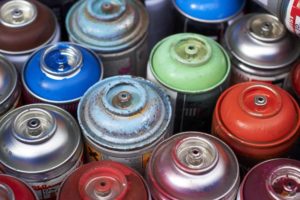An aerosol can is a pressurized container that releases a spray when you push down on a nozzle. They are common household items that hold cleaning products, spray paint, hair care products, air fresheners, and much more. Because they’re under pressure, aerosol cans must be disposed of properly to avoid environmental hazards.
Unfortunately many people do not know what to do with empty aerosol cans and they often end up in the trash. In this article we will cover what you need to know about recycling and disposing of your aerosol spray cans.
Are Aerosol Cans Recyclable?
Yes aerosol cans are recyclable. They are almost always made of steel covered in tin or aluminum, which are high value and can be recycled endlessly for use and reuse over and over. For this reason, it is a great idea to make the effort to recycle your household aerosol cans. Those empty spray paint cans and cans of hairspray shouldn’t end up in a landfill; they can be broken down and used again and again. However, there are some special considerations regarding aerosol can disposal because they contain propellants that are often flammable.
Where Can I Recycle Aerosol Cans Near Me?
Some cities include aerosol cans in their regular recycling bin programs, but it is important to check exactly what your city or county policy is before just dumping them in with all your other recyclables. Aerosol cans can often be omitted from regular city recycling programs because the pressurized cans can explode due to high heat or pressure.

If you are taking them into a recycling center that accepts aerosol cans it may be necessary to separate them. You can use a magnet to determine which cans are steel and which cans are aluminum. If the magnet sticks to the can then it is steel, otherwise it’s aluminum, just like soda cans. If your local waste management does NOT accept aerosol cans you will need to locate a recycling center or collection spot that does, or unfortunately, they will have to be disposed of through your city’s hazardous/universal waste program. Many times there will be a designated HHW drop-off location or special dates and times for disposal of these types of items along with paints, oils, and other waste items not suitable for regular trash cans.
How to Recycle Aerosol Cans
- Make sure the can is as empty as possible. Even if the product inside is harmless or non-hazardous, like whipping cream, you will need to empty it as much as possible. Shake the can and press the nozzle until there is no more product dispensing and all the pressurized gas is released.
- Aerosol cans usually come with small plastic caps, be sure to remove these and recycle separately with similar plastics. Different plastics are recycled differently usually based on the numbers imprinted on them. Recycle these plastics with similar plastic recyclables and separate from the metal aerosol containers.
- Do not ever attempt to puncture an aerosol can either to get more product out or to release the pressure. The can holds pressurized air and will explode and could harm you. Just empty as much out as possible by pressing the nozzle.
- Lastly, you will need to check if your local recycling center accepts aerosol cans or if they consider them Household Hazardous Waste, in which case you will need to dispose of them through their Household Hazardous Waste (HHW) program instead of recycling. Some city and county waste management programs even allow for recycling these items along with your regular bottles and cans.
Alternatives to Aerosol Cans
Even though CFCs have been banned since way back in 1978 by the EPA, many people still choose to avoid aerosols anyways. The cans they come in are harder to recycle, due to their flammable nature and the inherent risk of exploding or causing fires. They also release tiny particles of whatever product into the air and create a toxic air environment. So for health reasons many choose to avoid aerosols whenever possible. There are easy alternatives to nearly any aerosol item:
- Swap canned whipped cream for a tub of whipped cream or better yet whip up your own at home, without all those added preservatives and chemicals.
- Spray deodorants can be swapped out for stick deodorants. If health is a concern try finding one that is naturally derived and aluminum-free.
- Use spray, non-pressurized hairspray instead of aerosol. There are so many options in hair products to help with hold, between gels and sprays, you have near endless choices.
- Replace aerosol cleaning products with alternative cleaners. Many environmentally conscious people have moved to simple, safe, homemade cleaners and utilize reusable containers like glass spray bottles that can be refilled endless times. This eliminates so much waste that usually ends up in a landfill.
- Use eco-friendly paints, brushes, rollers instead of aerosol spray paints. Try using low VOC paints to lower the toxicity level and improve the air quality in your home. Studies have shown that of the over 300 known carcinogens in regular household paints, only about half is released within the first year, the rest continues to seep out and pollute your air quality for several years.
Uses for Recycled Aerosol Cans
Aerosol cans are made from steel or aluminum usually coated with tin. These metals are high value and very versatile, they can be utilized into containers for foods, beverages, household products, and more – an infinite number of times. Anything made out of steel or aluminum could have once been a can of hairspray or aerosol window cleaner. Pay attention while shopping and choose products that use previously recycled materials whenever possible to help support businesses that are helping the environment whenever possible, and doing their part to keep as much waste as possible out of our landfills.

